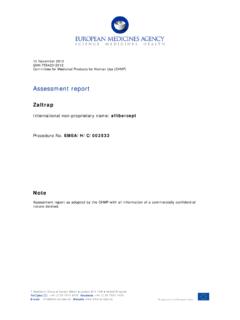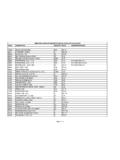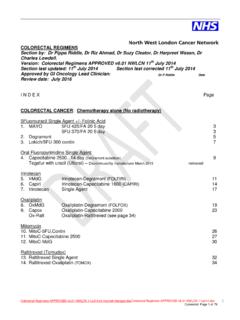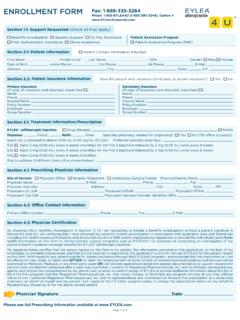Transcription of ANNEX I SUMMARY OF PRODUCT CHARACTERISTICS
1 ANNEX I. SUMMARY OF PRODUCT CHARACTERISTICS . 1. 1. NAME OF THE MEDICINAL PRODUCT . ZALTRAP 25 mg/ml concentrate for solution for infusion 2. QUALITATIVE AND QUANTITATIVE COMPOSITION. One ml of concentrate for solution for infusion contains 25 mg aflibercept *. One vial of 4 ml of concentrate contains 100 mg of aflibercept . One vial of 8 ml of concentrate contains 200 mg of aflibercept . * aflibercept is produced in a Chinese hamster ovary (CHO) K-1 mammalian expression system by recombinant DNA technology. For the full list of excipients, see section 3. PHARMACEUTICAL FORM. Concentrate for solution for infusion (sterile concentrate). The concentrate is a clear colourless to pale yellow solution. 4. CLINICAL PARTICULARS. Therapeutic indications ZALTRAP in combination with irinotecan/5-fluorouracil/folinic acid (FOLFIRI) chemotherapy is indicated in adults with metastatic colorectal cancer (MCRC) that is resistant to or has progressed after an oxaliplatin-containing regimen.
2 Posology and method of administration ZALTRAP should be administered under the supervision of a physician experienced in the use of antineoplastic medicinal products. Posology The recommended dose of ZALTRAP, administered as an intravenous infusion over 1 hour, is 4 mg / kg of body weight, followed by the FOLFIRI regimen. This is considered as one treatment cycle. The FOLFIRI regimen to be used is irinotecan 180 mg/m2 intravenous infusion over 90 minutes and folinic acid (dl racemic) 400 mg/m intravenous infusion over 2 hours at the same time on day 1 using a Y-line, followed by 5-fluorouracil (5-FU) 400 mg / m intravenous bolus, followed by 5-FU. 2400 mg / m continuous intravenous infusion over 46 hours. The treatment cycle is repeated every 2 weeks. ZALTRAP treatment should be continued until disease progression or unacceptable toxicity occurs.
3 2. Dose modification ZALTRAP should be discontinued for (see section ): Severe haemorrhage Gastrointestinal (GI) perforation Fistula formation Hypertension that is not adequately controlled with anti-hypertensive therapy or occurrence of hypertensive crisis or hypertensive encephalopathy Cardiac failure and ejection fraction decreased Arterial thromboembolic events (ATE). Grade 4 venous thromboembolic events (including pulmonary embolism). Nephrotic syndrome or thrombotic microangiopathy (TMA). Severe hypersensitivity reactions (including bronchospasm, dyspnoea, angioedema, and anaphylaxis) (see sections and ). Compromised wound healing requiring medical intervention Posterior reversible encephalopathy syndrome (PRES) (also known as reversible posterior leukoencephalopathy syndrome (RPLS)).
4 ZALTRAP should be temporarily suspended for at least 4 weeks prior to elective surgery (see section ). ZALTRAP/FOLFIRI Treatment delay or dose modification Neutropenia or thrombocytopenia Administration of ZALTRAP/FOLFIRI should be delayed (see sections and ) until neutrophil count is x 109/L or platelet count is 75 x 109 /L. Febrile neutropenia or neutropenic Irinotecan dose should be reduced by 15-20 % in subsequent sepsis cycles. If recurrence, 5-FU bolus and infusion doses should additionally be reduced by 20 % in subsequent cycles. If recurrence after irinotecan and 5-FU dose reductions, reduction of ZALTRAP dose to 2 mg/kg could be considered. The use of granulocyte colony-stimulating factor (G-CSF). may be considered. Mild to moderate hypersensitivity The infusion should be temporarily suspended until the reactions to ZALTRAP (including reaction resolves.)
5 Treatment with corticosteroids and/or flushing, rash, urticaria, and pruritus) antihistamines can be used as clinically indicated. (see section ). Pre-treatment with corticosteroids and/or antihistamines may be considered in subsequent cycles. Severe hypersensitivity reactions ZALTRAP/FOLFIRI should be discontinued and appropriate (including bronchospasm, dyspnoea, medical therapy should be administered. angioedema, and anaphylaxis). (see sections and ). ZALTRAP Treatment delay and dose modification Hypertension ZALTRAP should be temporarily suspended until (see section ) hypertension is controlled. In case of recurrent medically significant or severe hypertension, despite optimal treatment, ZALTRAP should be suspended until the hypertension is controlled and the dose reduced to 2 mg / kg for subsequent cycles.
6 3. Proteinuria ZALTRAP should be suspended when proteinuria 2 grams (see section ) per 24 hours and resumed when proteinuria < 2 grams per 24 hours. If recurrence, the treatment should be suspended until <2 grams per 24 hours and then the dose reduces to 2 mg/kg. FOLFIRI Dose modification when used in combination with ZALTRAP. Severe stomatitis and Palmar-Plantar 5-FU bolus should be reduced and the infusion dose reduced Erythrodysaesthesia syndrome by 20 %. Severe diarrhoea Irinotecan dose should be reduced by 15-20 %. If severe diarrhoea recurs on a subsequent cycle, the 5-FU. bolus and infusion dose should also be reduced by 20 %. If severe diarrhoea persists with both dose reductions, FOLFIRI should be discontinued. Treatment with anti-diarrhoeal medicinal products and rehydration can be used as needed.
7 For additional toxicities related to irinotecan, 5-FU, or folinic acid, refer to the current respective SUMMARY of PRODUCT CHARACTERISTICS . Special populations Elderly In the pivotal MCRC study, % of patients were aged 65 and < 75 and % of patients were aged 75. No dose adjustments of ZALTRAP is required in the elderly people. Hepatic impairment There have been no formal studies with ZALTRAP in patients with hepatic impairment (see section ). Clinical data suggest that no change in aflibercept dose is required in patients with mild to moderate hepatic impairment. There are no data regarding the administration of aflibercept in patients with severe hepatic impairment. Renal impairment There have been no formal studies with ZALTRAP in patients with renal impairment (see section ).
8 Clinical data suggest that no change in starting dose is required in patients with mild to moderate renal impairment. There are very limited data in patients with severe renal impairment; therefore, these patients should be treated with caution. Paediatric population There is no relevant use of ZALTRAP in the paediatric population for the indication of metastatic colorectal cancer. Method of administration ZALTRAP is to be administered only as an intravenous infusion over 1 hour. Due to hyperosmolality (1000 mOsmol/kg) of the ZALTRAP concentrate, undiluted ZALTRAP concentrate must not be administered as an intravenous push or bolus. ZALTRAP must not be administered as an intravitreal injection (see sections and ). Each vial of concentrate for solution for infusion is for single use (single-dose) only.
9 4. Precautions to be taken before handling or administering the medicinal PRODUCT For instructions on dilution of the medicinal PRODUCT before administration, and on infusion sets for administration, see section Contraindications Hypersensitivity to aflibercept or to any of the excipients listed in section Ophthalmic / intravitreal use due to hyperosmotic properties of ZALTRAP (see section ). For contraindications related to FOLFIRI components (irinotecan, 5-FU, and folinic acid), refer to the current respective SUMMARY of PRODUCT CHARACTERISTICS . Special warnings and precautions for use Haemorrhage An increased risk of haemorrhage, including severe and sometimes fatal haemorrhagic events has been reported in patients treated with aflibercept (see section ).
10 Patients should be monitored for signs and symptoms of GI bleeding and other severe bleeding. aflibercept should not be administered to patients with severe haemorrhage (see section ). Thrombocytopenia has been reported in patients treated with the ZALTRAP/FOLFIRI regimen. Monitoring of complete blood count (CBC) with platelets is recommended at baseline, prior to initiation of each cycle of aflibercept , and as clinically necessary. Administration of the ZALTRAP/FOLFIRI should be delayed until platelet count is 75 x 109 / L (see section ). Gastrointestinal perforation GI perforation including fatal GI perforation has been reported in patients treated with aflibercept (see section ). Patients should be monitored for signs and symptoms of GI perforation. aflibercept treatment should be discontinued in patients who experience GI perforation (see section ).

















